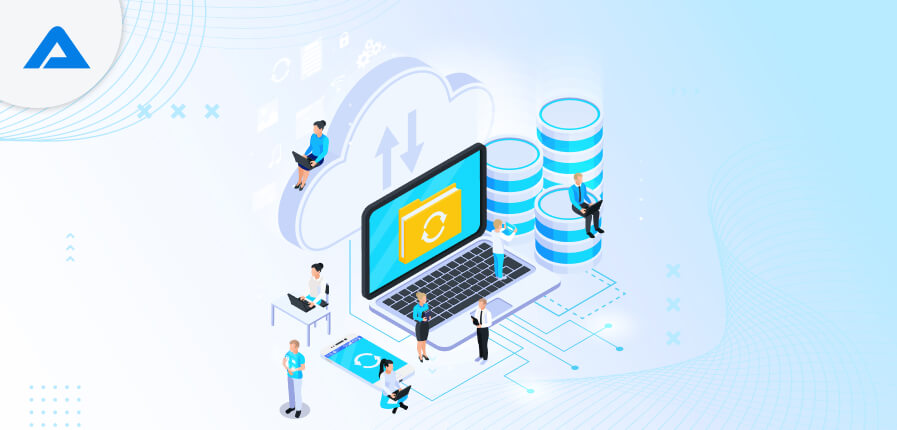Cloud computing has many advantages that are enticing businesses, regardless of size, to push towards transforming their businesses towards this new technology. It speeds up enterprises’ digital transformation efforts, allowing businesses to be more flexible and efficient in their operations and offer superior customer service.
Yet, despite the many advantages and the massive investment in cloud computing, 33% of companies have not seen any or a slight increase in their effectiveness since switching to the cloud. These figures indicate that cloud migration is complicated and expensive. A single error can cause lengthy delays, disruptions, or interruptions.
How do you transfer all your data assets into cloud storage while getting the promised benefits? The answer is in planning and selecting the appropriate cloud migration strategy that fits your business’s needs.
Let’s begin by examining the fundamentals of cloud migration and why it’s essential for a smooth transition to the cloud platform. This guide will take you through the fundamentals of a successful cloud-based data migration strategy.
What Is Cloud Data Migration and Why Is It Necessary?
Cloud data migration transfers data from a local infrastructure or another cloud-based system, such as a public cloud (Amazon Web Services, Microsoft Azure, or Google Cloud Platform) or a private cloud as a Cloud Enablement and Transformation component.
Businesses must utilize cloud service providers’ flexibility, cost-efficiency, and sophisticated capabilities. When data moves into the cloud, companies can maximize resource usage, reduce operational costs, enhance disaster recovery capabilities, gain access to the latest technologies, enhance access and collaboration, and increase flexibility and creativity. However, proper planning, execution, and safeguards are essential to secure and successful cloud-based data transfer.

Empower your Business with Cutting-edge Cloud Web Solutions!

Pooja Upadhyay
Director Of People Operations & Client Relations
Step By Step Guide For Data Migration To Cloud
Assess Your Data and Business Requirements
Before you embark on a cloud-based data migration process, it is crucial to analyze your business and data requirements and understand the fundamentals of “what is data migration in cloud computing.” Find out what data sets must be transferred in terms of their size, complexity, and importance. Be careful with your regulatory and compliance obligations and your company’s long-term and short-term goals. This will allow you to choose the right cloud platform, the best migration strategy, and the resources needed.
Choose the Right Cloud Platform
With so many cloud service providers (CSPs) available, selecting the best one is vital, particularly regarding efficient data management solutions. Consider security, scalability, performance, and compatibility with existing systems. Also, consider where the cloud data centers are, the company’s pricing plans, and service level agreements (SLAs). Microsoft Azure, Amazon Web Services (AWS), and Google Cloud Platform are well-known cloud platforms that various tech giants often use.
Develop a Migration Strategy
Develop an extensive migration plan based on your evaluation and cloud platform. This should include a thorough program for data migration, application cutting over, and testing. Consider factors like downtime or data integrity, as well as business continuity. Find out if a shift-and-lift approach (moving data in the same way) instead of a platform re-platforming method (modifying applications to use cloud-based services) is better suited to your company.
Ensure Data Security and Compliance
Data security and compliance must be at the top of your cloud data migration plans. Use secure security measures, including encryption, access control, and firewalls, to safeguard your data during and follow the migration process. Be sure to comply with specific industry laws, like GDPR, HIPAA, or PCI-DSS, depending on your company’s domain.
Testing and Validation
Testing is an essential element of the success of a cloud data migration, which includes not only the migration process but also cloud-to-cloud scenarios for data transfer. Conduct thorough tests to confirm data integrity, app functionality, and performance following the transfer. Find and fix any problems or incompatibilities before making the move live. Consider implementing a pilot project to test your approach on a smaller scale before conducting a full-scale migration.
Train Your Team and Manage Change
Cloud data migration typically requires new processes, technologies and workflows. Ensure your team is well-trained and able to operate in the cloud-based environment. Plan a change management program to deal with any resistance and make the transition smooth for your company.
Monitor and Optimize
Monitor your cloud environment carefully to ensure maximum performance, security, and cost-effectiveness. Utilize analytics and monitoring tools to find bottlenecks, possible issues, and areas for improvement. Review and continually adjust your cloud strategy to keep pace with your business’s changing needs and technological advancements.
Cloud Migration Benefits
Here are a few advantages that make it imperative for enterprises to shift their resources to the cloud:
Scalability
Cloud computing is scalable enough to handle larger loads and more users faster than infrastructure on-premises. When using traditional IT environments, businesses had to purchase and install physical servers, software licenses, networking, and storage equipment to increase the number of business services available.
Cost
Cloud providers provide managed services that reduce operating costs and ease maintenance tasks like upgrades. Businesses that migrate to the cloud will spend less money operating IT facilities, allowing them to focus more on other resources for innovation—developing new products or improving existing products.
Performance
Moving to the cloud ultimately enhances performance and the user experience. Websites and applications hosted in the cloud can easily scale to accommodate more significant numbers of users or a higher rate of performance and operate in locations close to users, reducing network latency.
Digital experience
Cloud users can access cloud services and data anywhere, whether customers or employees. This helps to transform the digital world, improving the customer experience and giving employees modern, flexible technology and tools.
What are The Main Factors to Consider Before Moving Data?
Data migration involves planning every aspect of this process. Here are some things to take into consideration.
Data online or offline migration
Moving a massive amount of data can be time-consuming and expensive, even with the most modern network solutions. In some companies, it may be more cost-effective and efficient to physically transfer information from one location to another via the storage device. This method is safer than transmitting data over the Internet.
Data format
It’s generally easy to move data in identical format from one place to another. For instance, moving databases from a local SQL Server to a cloud-based SQL Server doesn’t require any schema or format modifications. However, you need an intermediary process step to convert your data into a different format before data center transfer.
Outage at the Operation
If you transfer information from one location to another, you may be impacted by system outages or delays. It is best to schedule your data transfer during times that are not peak to limit the impacts. Many companies delay data migration because they need more downtime for their systems. However, this could cause more interruptions in the future.

What are The Types Of Cloud Migration?
Organizations can choose between different cloud migrations according to their needs.
Full data center exit
A complete data center exit transfers all application data, services, and other information from one data center to the shared cloud. Depending on the size of the company and the data center, a complete data center exit could be a long-lasting process that takes more than one calendar year to plan, test, and execute.
Migration between one cloud and the next
An organization might wish to change from one cloud provider to another for various reasons, such as changes to the terms of service agreements, improved security methods, or access to advanced artificial machine learning and artificial intelligence tools. Major cloud providers typically offer tools, services, and lists of third-party vendors who can aid an organization in moving from one cloud provider to another.
Transferring specific data or applications
Instead of a complete data center shutdown, businesses may want to transfer certain applications’ data, services, or databases from their on-premise servers to cloud storage, making them more productive and easier to manage. Data analytics, business intelligence, customer resource management (CRM), artificial intelligence, machine learning applications, and data sets are typical applications transferred to public cloud services.
Moving specific work
The more targeted migrations could be based on a particular type of workload. Resources running in the cloud consume specific resources, like storage capacity or computing power. Examples include developing environments, document management, creating remote databases, and modeling in 3D or video encoders.
What are Common Cloud Migration Challenges?
Moving cloud resources can prove complicated and extremely risky. Here are some of the most critical challenges many companies face when they do so.
Lack of Strategy
Many companies have begun migrating to cloud computing and need more time to understand their plan’s strategy. Implementation of cloud migration technology requires full-fledged planning. Every application and data set could have distinct needs and requirements, though requirements can fulfilled with the size, type, and capacity of the business that may require a different approach for cloud migration. The company must develop a clearly defined reason for each task transferred onto the cloud.
Cost Management
Many companies still need to set specific KPIs when transferring to cloud computing to determine how much they will spend or save following the move. Thus, it is difficult to determine whether the migration was successful from a financial point of view. Cloud environments are constantly changing, and prices are subject to change when new services are introduced and application usage increases.
Vendor Lock-In
Vendor Lock-In is a frequent issue for those adopting cloud technology. Cloud providers provide many services, but most need to be expanded to different cloud providers. Transferring applications from one platform to the next is a costly and lengthy process. Many businesses begin using cloud-based services but then find it difficult to change providers when the provider they are using isn’t suitable for their needs.
Data Security and Compliance
Data protection and safety are among the common concerns of businesses using cloud storage services. Cloud service providers have a shared responsibility: They take care of their framework, and the client is responsible for the security of their information and jobs.
Although the cloud provider might offer robust security features, your business must properly configure them and ensure that the right security measures protect all your applications and services.
The migration process itself poses security risks. Moving large volumes of sensitive data and setting access control for applications across multiple environments can result in substantial risk.
7 Cloud Migration Strategies
Seven cloud-based migration strategies include redeployment and rehosting, refactoring, repurchasing retirement, and keeping. They were initially referred to as”the “5 Rs” by Gartner and then extended into “7 Rs”. Companies looking to move to the cloud must consider the best strategy for migration to meet their requirements. Here is a brief description of each:
- Refactor/Re-architect. This involves redesigning an application by changing its structure and using cloud-native functions to increase performance, agility, and the ability to scale. It typically involves transferring the operating system and database.
- Replatform (Lift and Reshape). Transfer an application to the cloud and incorporate some improvements to use cloud-based capabilities.
- Repurchase (Drop and Shop): When you change to a different service, typically by implementing the SaaS approach instead of the traditional licensing strategy.
- Rehost (Lift and Shift) transfers an application to the cloud without changing to take advantage of cloud features.
- Relocate (Hypervisor-Level Lift and Shift). Move your infrastructure from the local to the cloud without requiring new hardware, software rewrites, or modifications to existing operations. Technology like VMware Cloud enables this migration method.
- Retain (Revisit). Keep applications running in their original environments. This includes applications that require major refactoring and may be delayed until an undetermined time in the future or legacy applications that have remained in place because there is no business reason to move.
- Retire. Remove or stop applications that are no longer needed within the origin environment.
Cloud Modernization Use Cases
BMC Software Reduces Conversion Time by 70%
BMC is a renowned cloud-based SaaS business. They upgraded their current system from PowerCenter to Informatica’s Intelligent Data Management Cloud(tm) (IDMC) as part of their cloud modernization strategy. With the help of Informatica’s Informatica Migration Factory, BMC transferred 4,000 table data and associated data from their databases. Informatica then concentrated on data pipelines and converted 5174 mappings and 217 workflows. BMC also accelerated the migration process through its own data ops capabilities and tools for data validation. The Migration Factory successfully migrated most of the PowerCenter mappings, with only one percent to be written manually. The result was a reduction in BMC’s expected time to convert by 70% and savings of 70% in code migration.
Driving Customer Engagement at McGraw Hill Education
McGraw Hill Education (MHE) is one of the “big three” educational publishers, which provides educational materials and software along with services for preschool up to postgraduate education. MHE accelerated its cloud-based journey by modernizing its cloud platform from PowerCenter into IDMC. In the interest of reducing TCO and time-to-market, MHE determined to combine integration services into one platform to accommodate all types of integration. Modernization can help them improve customer satisfaction, achieve cost savings, and speed up the time-to-market.
Pfizer Reduces the Time Needed to Manage Orders by 50%
In the COVID-19 clinical trials, where speed was crucial, the global pharmaceutical and technology company Pfizer reduced the time required to track the distribution of orders and manufacturing facilities by 50 percent. They combined and moved their on-premises legacy workloads used for supply chain analytics to the cloud. The seamless integration of the new cloud-based data management system and Pfizer’s database warehouse let them reuse the logistics business process they had developed, safeguarding years of on-premises investment and saving costs for data transfer. Cloud-based data management tools make up 99% of programming, drastically cutting development time. Pfizer has also reduced the loading times of 5 million data records from 19 hours (with hand-coding) to only four hours.
Conclusion
Cloud data migration is a complex task, but when properly planned, executed, and continuously managed, businesses can benefit from cloud computing while minimizing risk and interruptions. Following the guide mentioned above, you will master moving data and realize the full potential of cloud-based processing and storage.
Furthermore, continuous monitoring, documentation, and cost management are essential to the success of a post-migration. When done correctly, businesses can move their data to the cloud quickly, maximize resources, improve performance, increase efficiency, and ensure constant advancement. It’s crucial to communicate effectively with the stakeholders, provide instruction, and utilize tools to satisfy the requirements of cloud-based data management.

Achieve Seamless Cloud Integration. Hire Our Experienced Consultants.

Pooja Upadhyay
Director Of People Operations & Client Relations

